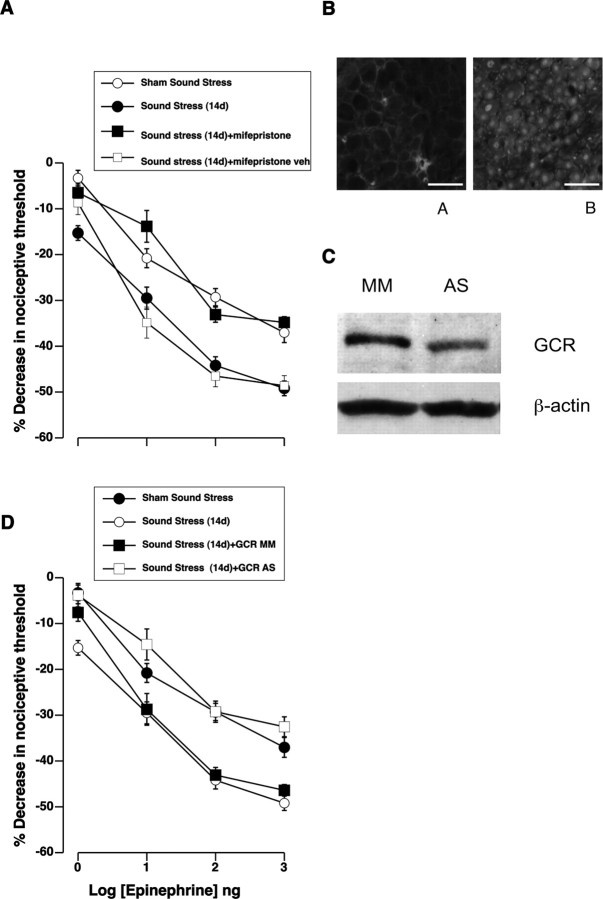Figure 2.
The effect of stress is mediated by glucocorticoid receptors in sensory neurons. A, Dose–response relationship for epinephrine hyperalgesia shows that systemic administration of the glucocorticoid receptor antagonist mifepristone (RU 38486), starting at the same time as initiation of sound stress and continuing for 13 d after, prevented the stress-induced enhancement of epinephrine hyperalgesia. All measurements were taken 14 d after the final exposure to sound stress. There was a significant main effect of mifepristone treatment on epinephrine hyperalgesia between the groups (F(3,132) = 23.5; p < 0.001). Post hoc analysis showed that subcutaneous injection of mifepristone (n = 12), but not its vehicle (n = 4), prevented sound-stress-induced enhancement of epinephrine hyperalgesia (p = 0.001). Epinephrine hyperalgesia in the mifepristone-treated group was not significantly different from that in the sham sound-stressed group (p > 0.05). B, Immunohistochemical analysis of the GCR expression in rat lumbar dorsal root ganglia. Anti-GCR immunoreactivity (ir) was detected in sensory neurons. As expected, anti-GCR-ir shows a predominantly nuclear distribution. A, Negative control, immunohistochemistry in the absence of the anti-GCR antibody. B, Immunohistochemistry in the presence of the anti-GCR antibody. Scale bars, 100 μm. C, Expression of glucocorticoid receptor was decreased in peripheral nerves after intrathecal antisense treatment. A 90 kDa band corresponding to the glucocorticoid receptor was detected by Western blotting of saphenous nerve. There was a 33 ± 8% decrease in protein expression in antisense compared with mismatch ODN-treated rats (p = 0.004, unpaired Student's t test; n = 11 for both antisense- and mismatch-treated rats). D, Glucocorticoid receptor antisense inhibits sound-stress-induced enhancement of epinephrine hyperalgesia. Rats were injected intrathecally daily with antisense (AS) or mismatch control (MM) oligodeoxynucleotides to the GCR. These rats were exposed to sound stress, and epinephrine hyperalgesia was measured at 14 d postexposure. The antisense, but not mismatch, ODN eliminated the enhancement of epinephrine hyperalgesia seen 14 d after sound stress. Overall ANOVA showed significant main effect of ODN treatment on epinephrine hyperalgesia between the groups (F(3,156) = 30.3; p < 0.001). Glucocorticoid receptor antisense treatment (n = 12) significantly inhibited stress-induced enhancement (n = 12) of epinephrine hyperalgesia [GCR AS compared with GCR MM or sound stress (14 d); p = 0.001]. Error bars indicate SEM.

